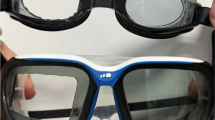Abstract
Purpose
The aim of this prospective study was to evaluate the intraocular pressure (IOP) variations during daily activities such as reading, speaking and carrying in regard to investigating whether an elevation or decrease exists.
Subjects and methods
Forty-four eyes of 44 healthy subjects were evaluated. The IOP was measured in relaxation and after reading, speaking and carrying a shopping bag for 5 min on different days, respectively. The subjects rested for 15 min between the activities. Mean initial IOP levels were compared with mean IOP levels after reading, speaking and carrying a shopping bag with paired t test. A p value of 0.05 was considered as statistically significant.
Results
We observed no changes in mean IOP after reading (p = 0.188). Mean IOP was increased after speaking and carrying compared with mean basic IOP (p = 0.001 and p = 0.001, very significant, respectively). The mean IOP began to decrease 15 min after speaking and carrying and came back to the baseline values one hour later.
Conclusions
The IOP is not stable during daily activities. Simple actions such as carrying or speaking have an increasing effect on IOP. This should be taken into consideration in glaucoma patients during control measurements, especially in patients in whom the IOP was near to the 20 mmHg border.
Similar content being viewed by others
References
Sit AJ, Liu JH (2009) Pathophysiology of glaucoma and continuous measurements of intraocular pressure. Mol Cell Biomech 6:57–69
Brody S, Erb C, Veit R, Rau H (1999) Intraocular pressure changes: the influence of psychological stress and the Valsalva maneuver. Biol Psychol 51:43–57
Bill A (1966) Conventional and uveoscleral drainage of aqueous humor in the cynomolgus monkey at normal and high intraocular pressure. Exp Eye Res 5:45–54
Gabelt BTG, Kaufman PL (2002) Aqueous humor hydrodynamics. In: Adler’s Physiology of the Eye; Clinical application, Tenth Ed. Mosby, St Louis pp 237–287
Lewin MR, Stein J, Wang R, Lee MM, Kernberg M, Boukhman M et al (2007) Humming is as effective as Valsalva’s maneuver and Trendelenburg’s position for ultrasonographic visualization of the jugular venous system and common femoral veins. Ann Emerg Med 50:73–77
Mete A, Kimyon S, Uzun I, Kara N (2014) Effects of valsalva maneuver on ocular biometric parameters: optical low-coherence reflectometry biometer study. Semin Ophthalmol 20:1–4
Zhang Z, Wang X, Jonas JB, Wang H, Zhang X, Peng X et al (2014) Valsalva manoeuver, intra-ocular pressure, cerebrospinal fluid pressure, optic disc topography: Beijing intracranial and intra-ocular pressure study. Acta Ophthalmol 92:475–480
Aykan U, Erdurmus M, Yilmaz B, Bilge AH (2010) Intraocular pressure and ocular pulse amplitude variations during the Valsalva maneuver. Graefes Arch Clin Exp Ophthalmol 248:1183–1186
Klein HE, Krohne SG, Moore GE, Mohamed AS, Stiles J (2011) Effect of eyelid manipulation and manual jugular compression on intraocular pressure measurement in dogs. J Am Vet Med Assoc 15:1292–1295
Dickerman RD, Smith GH, Langham-Roof L, McConathy WJ, East JW, Smith AB (1999) Intra-ocular pressure changes during maximal isometric contraction: does this reflect intra-cranial pressure or retinal venous pressure? Neurol Res 21:243–246
Faschinger C, Mossböck G (2010) Continuous 24 h monitoring of changes in intraocular pressure with the wireless contact lens sensor Triggerfish™. First results in patients (Article in German). Ophthalmologe 107:918–922
Vieira GM, Oliveira HB, de Andrade DT, Bottaro M, Ritch R (2006) Intraocular pressure variation during weight lifting. Arch Ophthalmol 124:1251–1254
Roddy G, Curnier D, Ellemberg D (2014) Reductions in intraocular pressure after acute aerobic exercise: a meta-analysis. Clin J Sport Med 24:364–372
Najmanova E, Pluhacek F, Botek M (2016) Intraocular pressure response to moderate exercise during 30-min recovery. Optom Vis Sci 93:281–285
Hong J, Zhang H, Kuo DS, Wang H, Huo Y, Yang D et al (2014) The short-term effects of exercise on intraocular pressure, choroidal thickness and axial length. PLoS ONE 9:e104294
Jenssen F, Krohn J (2010) Effects of static accommodation versus repeated accommodation on intraocular pressure. J Glaucoma 21:45–48
Read SA, Collins MJ, Becker H, Cutting J, Ross D, Savill AK et al (2010) Changes in intraocular pressure and ocular pulse amplitude with accommodation. Br J Ophthalmol 94:332–335
Acknowledgements
All authors certify that they have no affiliations with or involvement in any organization or entity with any financial interest (such as honoraria; educational grants; participation in speakers bureaus; membership, employment, consultations, stock ownership or other equity interest; and expert testimony or patent–licensing arrangements) or non-financial interest (such as personal or professional relationships, affiliations, knowledge or beliefs) in the subject matter or materials discussed in this manuscript.
Author information
Authors and Affiliations
Corresponding author
Ethics declarations
Conflicts of interest
The authors declare no conflict of interest.
Rights and permissions
About this article
Cite this article
Baser, G., Karahan, E., Bilgin, S. et al. Evaluation of the effect of daily activities on intraocular pressure in healthy people: is the 20 mmHg border safe?. Int Ophthalmol 38, 1963–1967 (2018). https://doi.org/10.1007/s10792-017-0684-2
Received:
Accepted:
Published:
Issue Date:
DOI: https://doi.org/10.1007/s10792-017-0684-2




